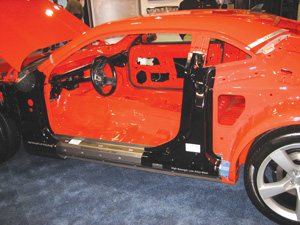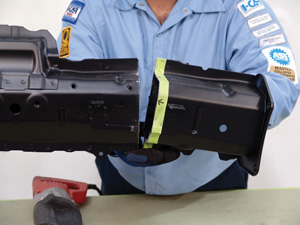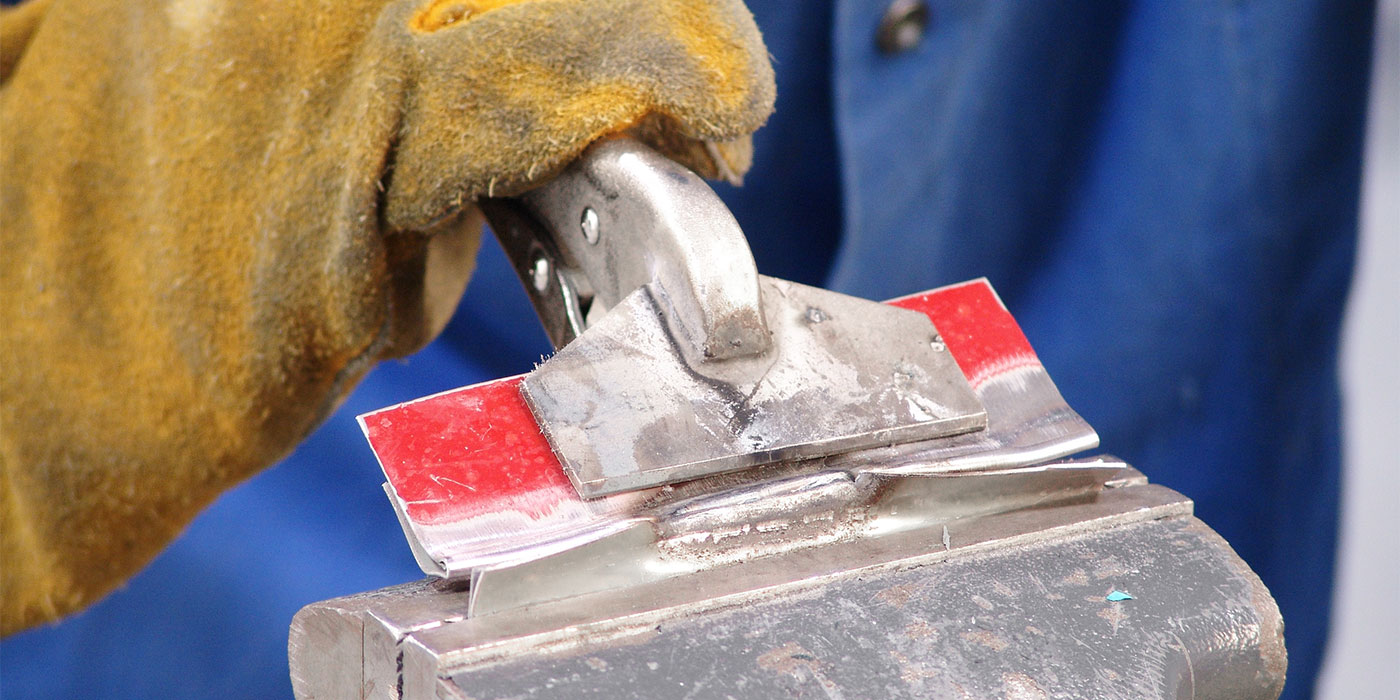
 In the first 70 or 80 years of the automotive industry, collision repairers worked mostly with mild steel in sheet metal parts and structural frames. Straightening could repair most of the damage, including as much heat and bending as necessary. As long as the parts ended up in the right shape, it was considered an acceptable repair and well-prepared for any subsequent collision.
In the first 70 or 80 years of the automotive industry, collision repairers worked mostly with mild steel in sheet metal parts and structural frames. Straightening could repair most of the damage, including as much heat and bending as necessary. As long as the parts ended up in the right shape, it was considered an acceptable repair and well-prepared for any subsequent collision.
The 1970s saw the introduction of unibody designs on a large scale, along with some high-strength steels. As more sophisticated collision energy management systems were produced in the following decades, ultra high-strength steels became more prevalent, and joining methods became more critical. These parts now had to be repaired and replaced with precise techniques to retain their function as well as form. Too much heat can affect the steel’s properties, so it may not react the same way in a subsequent collision.
The 2000s saw the introduction of additional advanced materials, further limitations on repair choices and new joining methods. By the 2010 model year, this trend jumped into hyper-drive, and more changes are coming. Many new factors affect collision repairs and are critical for restoring collision energy management systems so the vehicle will again perform as designed in a subsequent collision.
Advanced Materials
Materials that are found in newer structural parts include advanced steels, aluminum, magnesium and carbon fiber. These different materials could be found throughout a vehicle, and the same part on two different vehicles could be made from two completely different materials. The advantages of developing and using these advanced materials in structural parts include lighter weight and higher strength. The disadvantages become big challenges in collision repair.
Materials are selected based on their strength and weight, as well as their ability to either absorb or transfer collision energy. This pre-planned absorption or transfer is critical for other safety systems, including air bag timing. A few milliseconds faster or slower, and the air bag can become ineffective in protecting passengers. Too slow, and passengers can impact the vehicle interior prior to deployment; too fast, and the air bag protection is diminished before it’s needed. Your collision repairs need to replicate the original engineering design more precisely than ever before, and these new materials present greater challenges during the repair process.
Mild steels are relatively flexible, with tensile strength below 180 MPa (MegaPascals, a measure of force needed to tear it apart). This would be equivalent to 26,100 psi (pounds per square inch). They could be heated, straightened and welded without significantly changing their characteristics or future performance. General repair techniques would apply to almost all of these mild steels.
Ultra high-strength steels begin around 800 MPa (116,000 psi), indicating very high strength with the trade-off of less flexibility. Working the metal could increase strength (work hardening) but also make it brittle. Heating the metal could change the composition of the metal grains, typically making the steel weaker. Either way, the metal would react differently in the next collision. Special repair techniques are needed for these steels.
Martensitic steels are in the 1200 MPA (174,000 psi) range, and boron steel is even higher. These are very strong and inflexible. Some of their strength comes from the percentage of carbon content or other additives in the steel. Additional strength is gained by the process of manufacturing both the steel and the individual part. Their characteristics can be easily altered during repairs with even minimal heat.
Structural aluminum parts have their own set of challenges. Aluminum alloys mix different components and forming processes to have certain characteristics for the exact collision energy management needs of that part. Repairing aluminum is very different than repairing steel, requiring special training, different equipment and a dedicated work area. Again, repairs involving structural aluminum parts must restore all of the collision energy management designed into the vehicle.
Magnesium alloys are lightweight materials with good noise and vibration dampening characteristics. They’re non-magnetic, and parts are typically made from castings. Magnesium parts are growing in use and may be found in several different vehicle parts, including core supports, engine crossmembers and instrument panel frames.
Carbon fiber parts are made with a reinforced composite material. This is typically a polymer reinforced with woven fibers or mats. It’s lightweight, thin and strong. Currently found on more high-end vehicles, carbon fiber parts are being used in more places every year, including radiator supports, hoods and floor panels. As technology improves and mass production brings the cost down, carbon fiber parts could become commonplace in average vehicles soon.
Repair Decisions
Characteristics of these advanced materials will affect your repair decisions. Knowing that work-hardening or excessive heat can change their energy management performance in a subsequent accident, careful attention must be paid to identifying the materials involved in a collision repair.
A damaged radiator support might be high-strength steel, aluminum, magnesium or carbon fiber. Each of these would have different repair considerations.
Repair decisions will depend on a part’s metal content. Knowing that heat can change metal characteristics will affect your decision to repair or replace a part. Outer panels may be mild steel but may have an advanced steel reinforcement behind it. Some have multiple layers of reinforcements, further limiting repair choices.
Many aluminum and magnesium parts are cast and are likely broken in an accident. Repair of these parts is limited, so replacement is the most common choice. Carbon fiber parts also have limited repairs; sometimes only minor paint work is allowed.
If a structural part needs to be replaced, there’s another decision to be made on where to splice and attach the replacement. Can it be sectioned or must it be replaced all the way back to a factory seam?
Early unibody designs with mild or simple high-strength steel could be sectioned with some universal guidelines. Over two decades ago, I-CAR recommended some general sectioning guidelines for use when the manufacturer had no procedures. I-CAR guidelines contained statements that included sectioning “in a uniform area,” not near holes larger than 3 mm and not in crush zones. In a 2007 I-CAR Advantage Online article, there was a question on whether general sectioning guidelines were still applicable. I-CAR concluded that they were not, due to the prevalence of new advanced materials in current structural parts.
Sectioning should only be done following manufacturer procedures to make sure the integrity and collision energy management will be the same after repairs as it was originally. The manufacturers have tested these repairs and know they work. If you decide to section in a different location or against vehicle makers’ recommendations, who will test your repairs?
Joining Methods
Along with advanced materials come advanced joining methods. Advanced materials not only need new attachment methods, but they must be done exactly where and how the manufacturer says. Simple bolted attachments can cause corrosion between dissimilar metals. Large heat effect zones can cause changes in the metal’s strength.
GMAW (Gas Metal Arc Welding, commonly known as Metal Inert Gas or MIG welding) creates a smaller heat effect zone and therefore is preferred on high strength steels over oxyacetylene torches that were commonly used on mild steel. As new advanced steels become even more sensitive to heat, STRSW (Squeeze-Type Resistance Spot Welding) is more commonly used to further minimize effects from heat. A short, high-intensity burst contains the resulting heat to a much smaller area than even MIG welding and therefore minimizes changes to the metal’s characteristics.
MIG brazing is a procedure for some manufacturers. Although it doesn’t fuse metal together, it works with a much lower temperature and still can create a strong joint. In the repair environment, STRSW, MIG welding or adhesive bonding may be approved joining methods to replace the factory brazing.
Laser welding is done by the manufacturer on some models, and the procedure cannot yet be reproduced in the repair environment. Removal is done by grinding through the top panel and following the manufacturer’s procedures for the part’s replacement.
Adhesive bonding is growing as an attachment method in manufacturing, as well as in repairs. This procedure doesn’t involve the heat associated with other methods and has less effect on advanced steel characteristics. A bonded joint can be made with adhesive alone, may include mechanical fasteners and can include some welding. Vehicle manufacturers may have specific recommendations by year, make, model and specific part.
Removing a bonded part may require heat, hydraulic equipment and glass removal tools. The process may destroy the part being removed, so care must be taken to preserve the remaining flange for replacement. Surface preparation, working time and curing time are all factors in adhesive bonding parts.
Rivets don’t introduce heat into the repair but require the exact type and installation method to retain the integrity of the joint. Rivets may be solid, hollow or blind. Special riveting equipment may be required to install them. In many instances, adhesives are applied to riveted joints. The vehicle manufacturer has already tested these joining procedures, so it’s important to follow their procedures during repairs.
Mechanical fasteners may need to be coated or otherwise insulated to avoid galvanic corrosion from connecting dissimilar metals. Coated bolts may need to be replaced to retain all of their coated performance. Adhesives may be used to insulate different metals. Without properly fastening a joint involving different metals, galvanic corrosion can begin to weaken the vehicle structure and change the way it reacts in a subsequent accident.
More Changes Coming
Advanced materials have provided lighter and stronger structural parts for today’s vehicles. More changes in materials can be expected in the near future with new CAFÉ (Corporate Average Fuel Economy) standards beginning in 2011. Along with these new materials will be additional repair procedures that have already been tested by the manufacturer.













